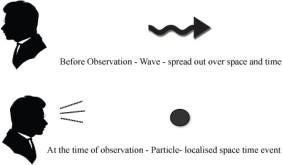The Quantum Leap
November 13, 2023
Welcome to the next installment of the “Quantum Leap Beginner Guides”, aimed at audiences without physics training and using only the most basic math (and even then, only when necessary). So far in this series we have reviewed the general concept of Quantum Mechanics, how quantum mechanics are leveraged via Qubits to take advantage of Wave-Particle Duality, Superposition, and Entanglement. I hope these earlier guides enabled readers to get a general sense of how we are now using some of the features of quantum mechanics to perform tasks and calculations never before possible. This introductory series now turns to the Observer Effect, another profound quantum property, although this quantum mechanical principle provides added challenges to leveraging quantum mechanics for useful applications.
At its core, the Observer Effect means that the simple act of observing a quantum property changes that property. It’s as if the photon or electron somehow knows it’s being watched and immediately stops what it was doing.
You may recall from the prior Wave-Particle Duality post that photons and electrons have wave characteristics, as elegantly proven by various versions of the famous “double-slit experiment.”
In panel (a) above, when a wave passes through the two slits, an interference pattern appears on the screen, confirming the wave behavior. In panel (b), large particles (think of bb’s) instead have particle behavior and make two sets of marks on the screen correlating with whichever slit the bb went through. In panel (c), if electrons are instead fired at the first panel, they form an
interference pattern on the screen, even when fired one at a time. This was a profound discovery and leveraging this “wave” nature of quantum particles drives much of the power behind quantum technologies. But wait, there’s more!
If experimenters place some sort of “eye” or detector at the place where the two double slits are, something profound happens.
You’ll note in the graphic above that placing a detector near each of the two double slits and having that detector record which slot each photon or electron passes through, will cause the interference pattern to disappear! When the quantum object is observed, its wave collapses and the object then behaves as a particle (not a wave). A scientist would say that:
“When an observer measures a particular property of a particle, they are effectively
collapsing the wave-function of that particle, causing it to assume a definite state.”
The physics to explain this is beyond the scope of this post (and this author!), but please accept it as true given it has been experimentally proven time and time again. Now let’s see how this impacts current efforts to advance quantum technologies.
Observer Effect Challenges to Quantum Computing and other Quantum Devices
As noted in the intro, most quantum mechanical properties are now being leveraged to provide powerful features of various applications including Quantum Computing. However, the Observer Effect is more of a hinderance than an asset, particularly in the following ways:
We can’t copy quantum states, so there is no quantum RAM.
We can’t view a quantum state mid-algorithm, which makes error correction challenging.
We can’t “clone” a qubit or quantum state, so quantum repeaters are very difficult to create, limiting the operating distance of quantum networks.
Quantum RAM or QRAM
Readers may be aware of the RAM (rapid access memory) in their desktop computer or their phone. My desktop computer has 64GB of RAM, which makes it a pretty powerful machine. It uses this RAM to temporarily store programs and data while I am operating my computer so that it can access that input rapidly (hence the “R” in RAM). at the risk of oversimplifying, RAM is essentially a temporary copy of other computer registers involved in a program or calculation.
This is an integral part of any computing system enabling quick and efficient data retrieval and manipulation.
However, as you may recall from prior posts, superposition is a core feature of quantum technologies. But if we can’t measure the qubit while in superposition (that would collapse its state because we would then be observing such state) we can’t make an exact copy of that qubit. This challenge is generally referred to as the “no-cloning theorem”. There are some creative workarounds that developers are pursuing, but to-date, there is no QRAM available, adding a layer of difficulty to creating Quantum Computers.
Quantum Error Correction
Current Quantum Computers are gaining power and capabilities by leaps and bounds, but all are currently operating in what is known as the NISQ (noisy intermediate-scale quantum) era. Given the noise, algorithm developers are working on creating ways to prevent or correct inevitable errors in quantum circuits caused by noise. But one major challenge in that regard is how do you know there is an error unless you check? And if you check, the qubit collapses and can no longer be used in the algorithm. Novel and creative ways to prevent, detect and correct qubits without actually measuring them are being developed and refined (i.e., parity checks), but no universal solution currently exists, and existing solutions consume a great amount of the compute overhead of existing Quantum Computers.
Quantum Repeaters
QKD (quantum key distribution) is a promising and rapidly advancing concept which will enable unprecedented levels of security in communications. Think unhackable networks. In fact, it is the observer effect that provides much of this security given that if an eavesdropper intercepts an encoded message, their sheer act of reading the message changes it and the recipient would immediately know someone had intercepted the message. Current quantum networks operate over fiber cables, and such cables lose the integrity of the signal after around 50 miles. Standard fiber cables, like the ones that might bring Internet service into your home, have repeaters at least every 50 miles, which takes in the signal, copies it and then re-amplifies it so it can travel further. Since measuring a quantum state collapses that state, quantum networks can’t simply copy the signal like ordinary networks.
Summary
In this post we learned that the act of observing a quantum object changes that object. There are broad practical and philosophical implications of that fact, which are fascinating to explore (if a tree falls in the forest and nobody hears it….). One of the practical implications is that it makes it even more difficult to leverage quantum effects since you can’t observe them until the very end of whatever process you are hoping to carry out. This limits the capabilities of Quantum Computers and quantum networks, among other new advances leveraging quantum effects.
Scientists and programmers are quite clever and various workarounds are being developed and refined, so I expect these challenges will be overcome.
Stay tuned to the Quantum Leap to learn more.
References:
Einstein silhouette image credit: “How Does Observing Particles Influence Their Behavior?”
Futurism.com, July 28, 2014.
Double-slit graphic panel: Aydin, Alhun,“Quantum Shape Effects,” Researchgate.net, February 2021.
Double-slit with observer/recorder image by Jacekgralak, “The Double-Slit Experiment: First step to Quantum Computing,” Medium.com, July 21, 2022.
Frackiewicz, Marcin, “Does quantum RAM exist?”, ts2.space, October 15, 2023.
Gottlieb, Larry, “What About the Quantum Physics Observer Effect?” larrygottlieb.com, June 13, 2022.
Siegel, Ethan, “Observing The Universe Really Does Change The Outcome, And This Experiment Shows How,” Forbes.com, May 26, 2020.
“What Is The Observer Effect In Quantum Mechanics,” scienceabc.com, May 10, 2019.
If you enjoyed this post, please visit my website and enter your email to receive future posts and updates:
http://quantumleap.blog
Russ Fein is a venture investor with deep interests in Quantum Computing (QC). For more of his thoughts about QC please visit the link to the left. For more information about his firm, please visit Corporate Fuel. Russ can be reached at russ@quantumleap.blog.








